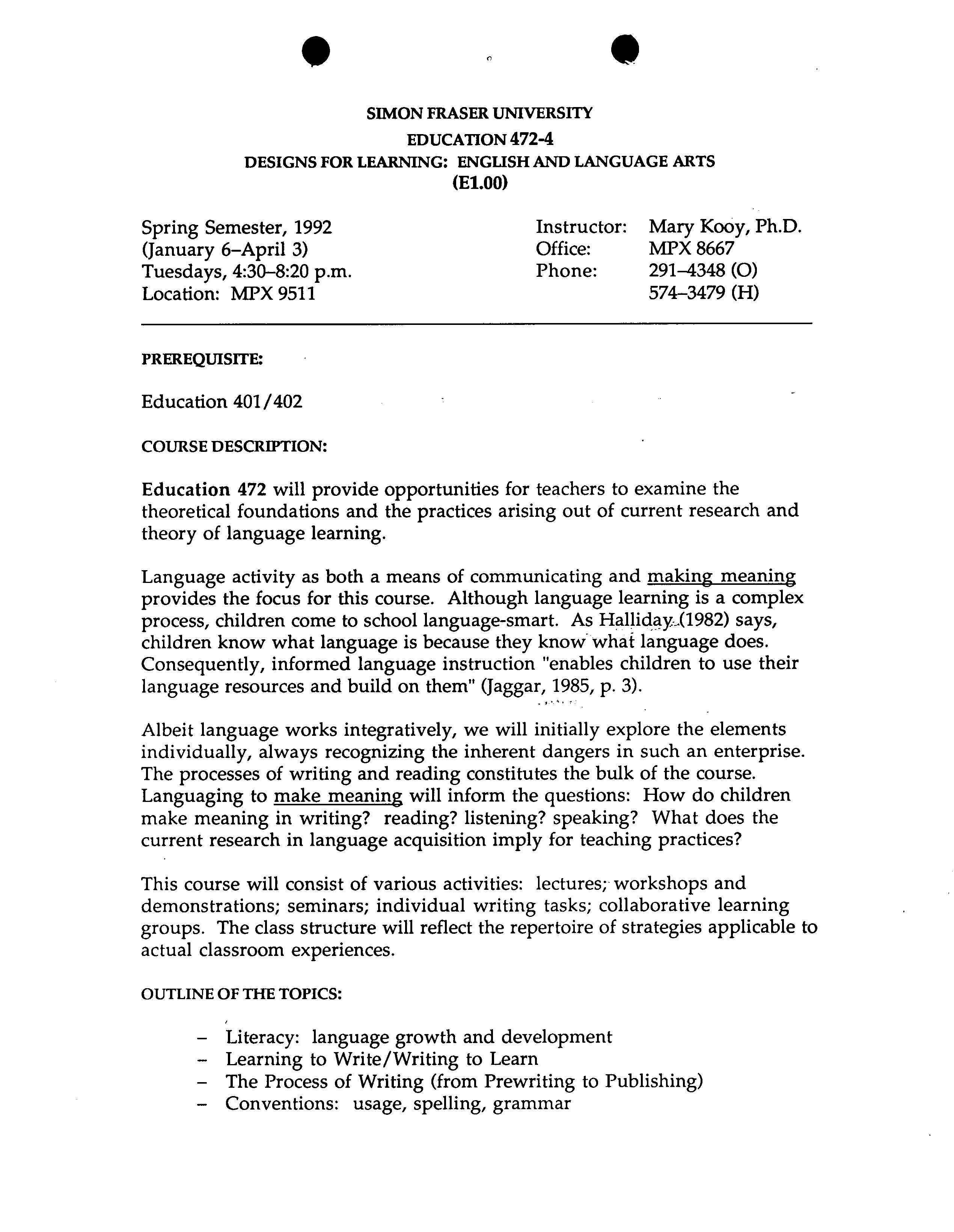SIMON FRASER UNIVERSITY
EDUCATION 472-4?
DESIGNS FOR LEARNING: ENGLISH AND LANGUAGE ARTS
?
(E1.00)
Spring Semester, 1992
?
Instructor: Mary Kooy, Ph.D.
(January 6—April 3)
?
Office: ?
MPX 8667
Tuesdays, 4:30-8:20 p.m. ?
Phone: ?
291-4348 (0)
Location: MPX 9511
?
574-3479 (H)
PREREQUISITE:
Education 401/402
COURSE DESCRIPTION:
Education 472
will provide opportunities for teachers to examine the
theoretical foundations and the practices arising out of current research and
theory of language learning.
Language activity as both a means of communicating and making meaning
provides the focus for this course. Although language learning is a complex
process, children come to school language-smart. As Hal1iday(1982) says,
children know what language is because they know what language does.
Consequently, informed language instruction "enables children to use their
language resources and build on them" (Jaggar, 1985,
p.
3).
Albeit language works integratively, we will initially explore the elements
individually, always recognizing the inherent dangers in such an enterprise.
The processes of writing and reading constitutes the bulk of the course.
Languaging to make meaning will inform the questions: How do children
make meaning in writing? reading? listening? speaking? What does the
current research in language acquisition imply for teaching practices?
This course will consist of various activities: lectures; workshops and
demonstrations; seminars; individual writing tasks; collaborative learning
groups. The class structure will reflect the repertoire of strategies applicable to
actual classroom experiences.
OUTLINE OF THE TOPICS:
-
Literacy: language growth and development
- Learning to Write/Writing to Learn
- The Process of Writing (from Prewriting to Publishing)
- Conventions: usage, spelling, grammar
0
?
.
-
Learning to Read/Reading to Learn
- The Role of Literature in the Curriculum
- Basal Readers
- Writing/Reading Connections
- Evaluation
- Designing 'Whole Language' Curriculum
COURSE REQUIREMENTS:
-
Attendance and participation in all aspects of the course
- Completion of assigned professional readings
- Weekly Double-Entry Journals in response to readings
- Response Log: Young Adult Novel
- Additional Written/Oral Presentation
REQUIRED TEXTS:
1.
Creating Classrooms for Authors: The Reading-Writing
Connection. Jerome Harste, Kathy Short, Carolyn Burke, et al.
Heinemann, 1988. ISBN: 0-435-08465-8.
2.
Understanding Whole Language: From Principles to Practice.
Constance Weaver, Heinemann, 1990. ISBN: 0-7725-1815-7.
3.
The Read-Aloud Handbook. Jim Trelease. Penguin, 1985. ISBN:
0-14-046.727-0.
SUGGESTED READING:
-
Writing and Reading to Learn. Nea Stewart-Dore, Editor. Primary
English Teacher's Assoc., Roselle, NSW, 1987. ISBN: 0-909955-65-4.
- Read On: A Conference Approach to Reading. David Hornsby,
Deborah Sukarna, Joanne Parry. Heinemann, 1986. ISBN: 0-435-
08459-3.
- In the Middle: Writing. Reading and Learning with Adolescents.
Nancie Atwell, 1987, Heinemann ISBN: 0-86709-163-0.


